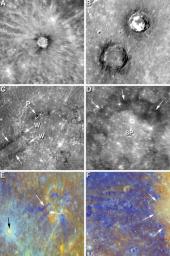
|
A Closer Look at Albedo and Color Variations on Mercury
- Click the image above for a larger view
- Full-Res JPEG (850 x 1280) (178.2 kB)
- Full-Res TIFF (850 x 1280) (3.3 MB)
Caption:
MESSENGER images have revealed intriguing albedo and color variations on Mercury, providing insight into the compositional differences in the rocks found on Mercury's surface and the processes that have acted on them. The term albedo simply refers to the fraction of light reflected by a material. For example, charcoal has a very low albedo while snow has a very high albedo. This figure, recently published in Science magazine, highlights some of these variations.
A: The bright rays of Basho crater (diameter about 80 kilometers, 50 miles) likely are made of immature material, while the darker material near the rim is thought also to be immature material but of a different composition. Surface materials on Mercury are believed to change color and albedo over time as a result of bombardment by micrometeoroids and energetic particles from the solar wind. They eventually reach an unchanging, "mature" state. If the surface is disturbed, for instance by a cratering impact, underlying material is freshly exposed on the surface. It is termed "immature" if the disturbance was sufficiently recent that there hasn't yet been time for the exposed material to gain maturity.
B: Two craters within PIA10383 Caloris basin have dark crater walls, and the crater at upper right, PIA10603 Sander (diameter about 50 kilometers, 30 miles), has bright patches on its floor. Unlike the rays of Basho crater, the bright areas are not believed to be immature but are inherently bright.
C: PIA10607 Mozart crater (diameter about 220 kilometers, 140 miles) shows linear dark streamers (unlabeled arrows), which are thought to be material excavated from depth during the crater-forming impact. Similarly colored dark patches can also be seen in the crater wall (arrows labeled W) and in the central peak (arrow labeled P) and may be derived from the same underground layer.
D: The smooth plains (labeled SP) interior to Tolstoj basin are superimposed on the darker areas shown with unlabeled arrows. Materials with these two color and albedo characteristics are common on Mercury's surface. This image is 825 kilometers (513 miles) wide.
E: This image was generated by comparing and contrasting WAC images taken in 11 different color filters and choosing a color scheme to highlight differences on Mercury's surface. The image shows the dark streamers of Mozart crater (white arrows) and a young impact crater with fresh, immature rays (black arrow). The image is about 800 kilometers (500 miles) wide.
F: Using a similar color scheme, this image of a segment of the edge and rim of Caloris basin (white arrows) clearly shows that the rocks present on the basin's floor differ from those exterior to the basin. This image is about 600 kilometers (370 miles) wide.
Date Acquired:
January 14, 2008
Image Mission Elapsed Time (MET):
A: 108828233. B: 108826687. C: 108827022. D: 108828337, 108828342. E, F: 108829678-108829728.
Instrument:
(A-D) Narrow Angle Camera (NAC) and (E-F) Wide Angle Camera (WAC) of the Mercury Dual Imaging System (MDIS)
Background Info:
These images are from MESSENGER, a NASA Discovery mission to conduct the first orbital study of the innermost planet, Mercury. For information regarding the use of images, see the MESSENGER image use policy .
Cataloging Keywords:
| Name | Value | Additional Values |
|---|---|---|
| Target | Mercury | |
| System | ||
| Target Type | Planet | |
| Mission | MESSENGER | |
| Instrument Host | MESSENGER | |
| Host Type | Orbiter | |
| Instrument | Mercury Dual Imaging System (MDIS) | |
| Detector | Narrow Angle Camera (NAC), Wide Angle Camera (WAC) | |
| Extra Keywords | Color, Crater, Impact | |
| Acquisition Date | ||
| Release Date | 2008-08-06 | |
| Date in Caption | 2008-01-14 | |
| Image Credit | NASA/Johns Hopkins University Applied Physics Laboratory/Arizona State University/Carnegie Institution of Washington. Figure 2 from Robinson et al., Science, 321, 66-69, 2008. | |
| Source | photojournal.jpl.nasa.gov/catalog/PIA11024 | |
| Identifier | PIA11024 | |
